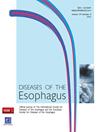Are the Chicago 3.0 manometric diagnostics consistent with Chicago 4.0?
IF 2.3
3区 医学
Q3 GASTROENTEROLOGY & HEPATOLOGY
引用次数: 0
Abstract
Summary There is little information on the degree of concordance between the results obtained using the Chicago 3.0 (CCv3.0) and Chicago 4.0 (CCv4.0) protocols to interpret high-resolution manometry (HRM) seeking to determine the value provided by the new swallowing maneuvers included in the last protocol. This is a study of diagnostic tests, evaluating concordance by consistency between the results obtained by the CCv3.0 and CCv4.0 protocols, in patients undergoing HRM. Concordance was assessed with the kappa test. Bland–Altman scatter plots, and Lin’s correlation-concordance coefficient (CCC) were used to assess the agreement between IRP measured with swallows in the supine and seated position or with solid swallows. One hundred thirty-two patients were included (65% women, age 53 ± 17 years). The most frequent HRM indication was dysphagia (46.1%). Type I was the most common type of gastroesophageal junction. The most frequent CCv4.0 diagnoses were normal esophageal motility (68.9%), achalasia (15.5%), and ineffective esophageal motility (IEM; 5.3%). The agreement between the results was substantial (Kappa 0.77 ± 0.05), with a total agreement of 87.9%. Diagnostic reclassification occurred in 12.1%, from IEM in CCv3.0 to normal esophageal motility in CCv4.0. Similarly, there was a high level of agreement between the IRP measured in the supine compared to the seated position (CCC0.92) and with solid swallows (CCC0.96). In conclusion, the CCv4.0 protocol presents a high concordance compared to CCv3.0. In the majority of manometric diagnoses there is no reclassification of patients with provocation tests. However, the more restrictive criteria of CCv4.0 achieve a better reclassification of patients with IEM.芝加哥 3.0 人体测量诊断与芝加哥 4.0 是否一致?
摘要 有关使用芝加哥 3.0(CCv3.0)和芝加哥 4.0(CCv4.0)方案解释高分辨率测压(HRM)所获结果的一致性程度的信息很少,目的是确定最后一个方案中包含的新吞咽动作所提供的价值。这是一项诊断测试研究,通过CCv3.0和CCv4.0协议在接受高分辨率测压的患者中获得的结果之间的一致性来评估一致性。一致性通过卡帕检验进行评估。使用Bland-Altman散点图和Lin相关-一致性系数(CCC)来评估仰卧位和坐位吞咽或固体吞咽时测量的IRP之间的一致性。共纳入 132 名患者(65% 为女性,年龄为 53±17 岁)。最常见的 HRM 适应症是吞咽困难(46.1%)。I 型是最常见的胃食管交界处类型。最常见的 CCv4.0 诊断是食管运动正常(68.9%)、贲门失弛缓症(15.5%)和食管运动无效(IEM;5.3%)。结果之间的一致性很高(Kappa 0.77 ± 0.05),总一致性为 87.9%。12.1%的患者出现了诊断重新分类,从CCv3.0的IEM到CCv4.0的正常食管运动。同样,仰卧位与坐位测量的 IRP(CCC0.92)和固体吞咽(CCC0.96)之间的一致性也很高。总之,与 CCv3.0 相比,CCv4.0 协议具有很高的一致性。在大多数测压诊断中,对接受激发试验的患者没有重新分类。然而,CCv4.0 更严格的标准能更好地对 IEM 患者进行重新分类。
本文章由计算机程序翻译,如有差异,请以英文原文为准。
求助全文
约1分钟内获得全文
求助全文
来源期刊

Diseases of the Esophagus
医学-胃肠肝病学
CiteScore
5.30
自引率
7.70%
发文量
568
审稿时长
6 months
期刊介绍:
Diseases of the Esophagus covers all aspects of the esophagus - etiology, investigation and diagnosis, and both medical and surgical treatment.
 求助内容:
求助内容: 应助结果提醒方式:
应助结果提醒方式:


